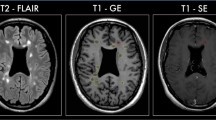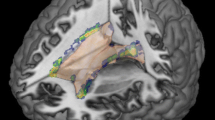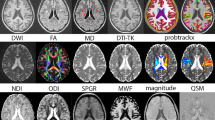Abstract
Background
Atrophied T2-lesion volume (LV) is a novel MRI marker representing brain-lesion loss due to atrophy, able to predict long-term disability progression and conversion to secondary-progressive multiple sclerosis (MS).
Objective
To better characterize atrophied T2-LV via comparison with other multidisciplinary markers of MS progression.
Methods
We studied 127 MS patients (85 relapsing–remitting, RRMS and 42 progressive, PMS) and 20 clinically isolated syndrome (CIS) utilizing MRI, optical coherence tomography, and serum neurofilament light chain (sNfL) at baseline and at 5-year follow-up. Symbol Digit Modalities Test (SDMT) was obtained at follow-up. Atrophied T2-LV was calculated by combining baseline lesion masks with follow-up CSF partial-volume maps. Measures were compared between MS patients who developed or not disease progression (DP). Partial correlations between atrophied T2-LV and other biomarkers were performed, and corrected for multiple comparisons.
Results
Atrophied T2-LV was the only biomarker that significantly differentiated DP from non-DP patients over the follow-up (p = 0.007). In both DP and non-DP groups, atrophied T2-LV was associated with baseline T2-LV and T1-LV (both p = 0.003), absolute change of T1-LV (DP p = 0.038; non-DP p = 0.003) and percentage of brain volume change (both p = 0.003). Furthermore, in the DP group, atrophied T2-LV was related to baseline brain parenchymal (p = 0.017) and thalamic (p = 0.003) volumes, thalamic volume change and follow-up SDMT (both p = 0.003). In non-DP patients, atrophied T2-LV was significantly related to baseline sNfL (p = 0.008), contrast-enhancing LV (p = 0.02) and percentage ventricular volume change (p = 0.003).
Conclusion
Atrophied T2-LV is associated with disability accrual in MS, and to several multimodal markers of disease evolution.

Similar content being viewed by others
References
Barro C, Benkert P, Disanto G, Tsagkas C, Amann M, Naegelin Y, Leppert D, Gobbi C, Granziera C, Yaldizli O, Michalak Z, Wuerfel J, Kappos L, Parmar K, Kuhle J (2018) Serum neurofilament as a predictor of disease worsening and brain and spinal cord atrophy in multiple sclerosis. Brain 141:2382–2391
Benedict RH, DeLuca J, Phillips G, LaRocca N, Hudson LD, Rudick R, Multiple Sclerosis Outcome Assessments C (2017) Validity of the symbol digit modalities test as a cognition performance outcome measure for multiple sclerosis. Mult Scler 23:721–733
Berger T (2017) Biomarkers in the evolution of multiple sclerosis. Neurodegener Dis Manag 7:3–6
Disanto G, Barro C, Benkert P, Naegelin Y, Schadelin S, Giardiello A, Zecca C, Blennow K, Zetterberg H, Leppert D, Kappos L, Gobbi C, Kuhle J, Swiss Multiple Sclerosis Cohort Study G (2017) Serum Neurofilament light: a biomarker of neuronal damage in multiple sclerosis. Ann Neurol 81:857–870
Dwyer MG, Bergsland N, Ramasamy DP, Jakimovski D, Weinstock-Guttman B, Zivadinov R (2018) Atrophied brain lesion volume: a new imaging biomarker in multiple sclerosis. J Neuroimaging 28:490–495
Dwyer MG, Bergsland N, Zivadinov R (2014) Improved longitudinal gray and white matter atrophy assessment via application of a 4-dimensional hidden Markov random field model. Neuroimage 90:207–217
El Ayoubi NK, Ghassan S, Said M, Allam J, Darwish H, Khoury SJ (2016) Retinal measures correlate with cognitive and physical disability in early multiple sclerosis. J Neurol 263:2287–2295
Filippi M, Rocca MA, Rovaris M (2002) Clinical trials and clinical practice in multiple sclerosis: conventional and emerging magnetic resonance imaging technologies. Curr Neurol Neurosci Rep 2:267–276
Gaiottino J, Norgren N, Dobson R, Topping J, Nissim A, Malaspina A, Bestwick JP, Monsch AU, Regeniter A, Lindberg RL, Kappos L, Leppert D, Petzold A, Giovannoni G, Kuhle J (2013) Increased neurofilament light chain blood levels in neurodegenerative neurological diseases. PLoS ONE 8:e75091
Gelineau-Morel R, Tomassini V, Jenkinson M, Johansen-Berg H, Matthews PM, Palace J (2012) The effect of hypointense white matter lesions on automated gray matter segmentation in multiple sclerosis. Hum Brain Mapp 33:2802–2814
Genovese A, Hagemeier J, Bergsland N, Jakimovski D, Dwyer M, Ramasamy D, Hojnacki D, Kolb C, Lizarraga A, Weinstock-Guttman B, Zivadinov R (2019) Atrophied T2 lesion volume is associated with disability progression and conversion to secondary-progressive multiple sclerosis. Radiology 293:424–433
Gordon-Lipkin E, Chodkowski B, Reich DS, Smith SA, Pulicken M, Balcer LJ, Frohman EM, Cutter G, Calabresi PA (2007) Retinal nerve fiber layer is associated with brain atrophy in multiple sclerosis. Neurology 69:1603–1609
Haider L, Zrzavy T, Hametner S, Hoftberger R, Bagnato F, Grabner G, Trattnig S, Pfeifenbring S, Bruck W, Lassmann H (2016) The topograpy of demyelination and neurodegeneration in the multiple sclerosis brain. Brain 139:807–815
Jakimovski D, Kuhle J, Ramanathan M, Barro C, Tomic D, Hagemeier J, Kropshofer H, Bergsland N, Leppert D, Dwyer MG, Michalak Z, Benedict RHB, Weinstock-Guttman B, Zivadinov R (2019) Serum neurofilament light chain levels associations with gray matter pathology: a 5-year longitudinal study. Ann Clin Transl Neurol 6:1757–1770
Jakimovski D, Zivadinov R, Ramanathan M, Hagemeier J, Weinstock-Guttman B, Tomic D, Kropshofer D, Barro C, Leppert D, Yaldizlil Ö, Kuhle J, Benedict R (2019) Serum neurofilament light chain levels associations with clinical and cognitive performance in multiple sclerosis: a longitudinal retrospective 5-year study. Mult Scler. https://doi.org/10.1177/1352458519881428
Kalb R, Beier M, Benedict RH, Charvet L, Costello K, Feinstein A, Gingold J, Goverover Y, Halper J, Harris C, Kostich L, Krupp L, Lathi E, LaRocca N, Thrower B, DeLuca J (2018) Recommendations for cognitive screening and management in multiple sclerosis care. Mult Scler 24:1665–1680
Kuhle J, Barro C, Andreasson U, Derfuss T, Lindberg R, Sandelius A, Liman V, Norgren N, Blennow K, Zetterberg H (2016) Comparison of three analytical platforms for quantification of the neurofilament light chain in blood samples: ELISA, electrochemiluminescence immunoassay and Simoa. Clin Chem Lab Med 54:1655–1661
Kuhle J, Barro C, Disanto G, Mathias A, Soneson C, Bonnier G, Yaldizli O, Regeniter A, Derfuss T, Canales M, Schluep M, Du Pasquier R, Krueger G, Granziera C (2016) Serum neurofilament light chain in early relapsing remitting MS is increased and correlates with CSF levels and with MRI measures of disease severity. Mult Scler 22:1550–1559
Kuhle J, Nourbakhsh B, Grant D, Morant S, Barro C, Yaldizli O, Pelletier D, Giovannoni G, Waubant E, Gnanapavan S (2017) Serum neurofilament is associated with progression of brain atrophy and disability in early MS. Neurology 88:826–831
Lazeron RH, Boringa JB, Schouten M, Uitdehaag BM, Bergers E, Lindeboom J, Eikelenboom MI, Scheltens PH, Barkhof F, Polman CH (2005) Brain atrophy and lesion load as explaining parameters for cognitive impairment in multiple sclerosis. Mult Scler 11:524–531
Louapre C, Govindarajan ST, Gianni C, Madigan N, Sloane JA, Treaba CA, Herranz E, Kinkel RP, Mainero C (2018) Heterogeneous pathological processes account for thalamic degeneration in multiple sclerosis: insights from 7 T imaging. Mult Scler 24(11):1433–1444
Lucchinetti CF, Popescu BF, Bunyan RF, Moll NM, Roemer SF, Lassmann H, Bruck W, Parisi JE, Scheithauer BW, Giannini C, Weigand SD, Mandrekar J, Ransohoff RM (2011) Inflammatory cortical demyelination in early multiple sclerosis. N Engl J Med 365:2188–2197
Mainero C, Louapre C, Govindarajan ST, Gianni C, Nielsen AS, Cohen-Adad J, Sloane J, Kinkel RP (2015) A gradient in cortical pathology in multiple sclerosis by in vivo quantitative 7 T imaging. Brain 138:932–945
Patenaude B, Smith SM, Kennedy DN, Jenkinson M (2011) A Bayesian model of shape and appearance for subcortical brain segmentation. Neuroimage 56:907–922
Polman CH, Reingold SC, Banwell B, Clanet M, Cohen JA, Filippi M, Fujihara K, Havrdova E, Hutchinson M, Kappos L, Lublin FD, Montalban X, O'Connor P, Sandberg-Wollheim M, Thompson AJ, Waubant E, Weinshenker B, Wolinsky JS (2011) Diagnostic criteria for multiple sclerosis: 2010 revisions to the McDonald criteria. Ann Neurol 69:292–302
Smith SM, Zhang Y, Jenkinson M, Chen J, Matthews PM, Federico A, De Stefano N (2002) Accurate, robust, and automated longitudinal and cross-sectional brain change analysis. Neuroimage 17:479–489
Srinivasan S, Efron N (2018) Optical coherence tomography in the investigation of systemic neurologic disease. Clin Exp Optom 102:309–319
Strober L, DeLuca J, Benedict RH, Jacobs A, Cohen JA, Chiaravalloti N, Hudson LD, Rudick RA, LaRocca NG, Multiple Sclerosis Outcome Assessments C (2019) Symbol digit modalities test: a valid clinical trial endpoint for measuring cognition in multiple sclerosis. Mult Scler 25(13):1781–1790
Tewarie P, Balk L, Costello F, Green A, Martin R, Schippling S, Petzold A (2012) The OSCAR-IB consensus criteria for retinal OCT quality assessment. PLoS ONE 7:e34823
Thaler C, Faizy TD, Sedlacik J, Holst B, Sturner K, Heesen C, Stellmann JP, Fiehler J, Siemonsen S (2017) T1 recovery is predominantly found in black holes and is associated with clinical improvement in patients with multiple sclerosis. AJNR Am J Neuroradiol 38:264–269
Toledo J, Sepulcre J, Salinas-Alaman A, Garcia-Layana A, Murie-Fernandez M, Bejarano B, Villoslada P (2008) Retinal nerve fiber layer atrophy is associated with physical and cognitive disability in multiple sclerosis. Mult Scler 14:906–912
Tonietto M, Poirion E, Papeix C, Bottlaender M, Bodini B, Stankoff B (2019) Periventricular remyelination is associated with grey matter atrophy in MS. European Committee for Treatment and Research in Multiple Sclerosis (ECTRIMS), Stockholm
Van Schependom J, Nagels G (2017) Targeting cognitive impairment in multiple sclerosis—the road toward an imaging-based biomarker. Front Neurosci 11:380
Zivadinov R, Horakova D, Bergsland N, Hagemeier J, Ramasamy DP, Uher T, Vaneckova M, Havrdova E, Dwyer MG (2019) A serial 10-year follow-up study of atrophied brain lesion volume and disability progression in patients with relapsing–remitting MS. AJNR Am J Neuroradiol 40:446–452
Zivadinov R, Jakimovski D, Gandhi S, Ahmed R, Dwyer MG, Horakova D, Weinstock-Guttman B, Benedict RR, Vaneckova M, Barnett M, Bergsland N (2016) Clinical relevance of brain atrophy assessment in multiple sclerosis. Implications for its use in a clinical routine. Expert Rev Neurother 16:777–793
Zivadinov R, Ramasamy DP, Vaneckova M, Gandhi S, Chandra A, Hagemeier J, Bergsland N, Polak P, Benedict RH, Hojnacki D, Weinstock-Guttman B (2017) Leptomeningeal contrast enhancement is associated with progression of cortical atrophy in MS: a retrospective, pilot, observational longitudinal study. Mult Scler 23:1336–1345
Zivadinov R, Tavazzi E, Hagemeier J, Carl E, Hojnacki D, Kolb C, Weinstock-Guttman B (2018) The effect of glatiramer acetate on retinal nerve fiber layer thickness in patients with relapsing-remitting multiple sclerosis: a longitudinal optical coherence tomography study. CNS Drugs 32:763–770
Funding
Funding was provided by Novartis Pharma AG, Basel, Switzerland and Swiss National Research Foundation (Grant number 320030_160221).
Author information
Authors and Affiliations
Corresponding author
Ethics declarations
Conflict of interest
The authors declare that there are no conflicts of interest with their article.
Rights and permissions
About this article
Cite this article
Tavazzi, E., Bergsland, N., Kuhle, J. et al. A multimodal approach to assess the validity of atrophied T2-lesion volume as an MRI marker of disease progression in multiple sclerosis. J Neurol 267, 802–811 (2020). https://doi.org/10.1007/s00415-019-09643-z
Received:
Revised:
Accepted:
Published:
Issue Date:
DOI: https://doi.org/10.1007/s00415-019-09643-z




